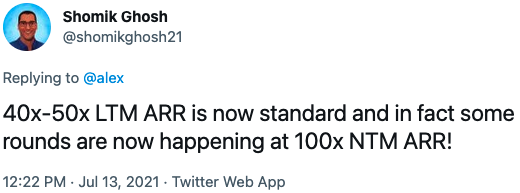How to make the math work for today’s sky-high startup valuations
Do low startup revenues compared to their valuations indicate that there are many houses of cards set to fall in time? The answer is maybe, but probably not. Let's discuss why the math can work.


Venture capital price discipline is out the window; venture funds are looking to make faster, earlier deals; and more unicorns were minted in the last three months than during any quarter in history. It’s a busy time for startups and their financial backers. Now weeks into July, it’s increasingly clear that 2021 is shaping up to be a record-setter for venture capital investment. And investors don’t expect the frenetic pace to slow.
The Exchange explores startups, markets and money. Read it every morning on Extra Crunch or get The Exchange newsletter every Saturday.
But while the dollars flowing into global startups are setting all-time records, deal volume is not tracking similar extremes. Global deal volume reached a record in the second quarter, but it just barely eked out a win over several quarters from 2018 and Q1 2021.
A flood of money invested against more modest deal flow has helped drive up startup valuations this year, along with deal sizes.
 CB Insights data indicates, for example, that median Series A valuations rose to $42 million thus far in 2021. That’s far above 2020’s median Series A valuation of $33 million, also beating the previous record set in 2019 of $39 million. The same dataset indicates that Series B, C, D and E rounds also reached new highs in 2021 compared to years going back to at least 2015.
CB Insights data indicates, for example, that median Series A valuations rose to $42 million thus far in 2021. That’s far above 2020’s median Series A valuation of $33 million, also beating the previous record set in 2019 of $39 million. The same dataset indicates that Series B, C, D and E rounds also reached new highs in 2021 compared to years going back to at least 2015.
So startups are getting larger checks, earlier. Does that mean that many startups are landing investments with smaller revenues than their stage (or capital base) would normally require? Yep.
Yesterday in a public discussion of startups valued at $1 billion or more — unicorns, in our modern parlance — Boldstart Ventures’ Shomik Ghosh said something that matched what The Exchange has heard from other investors, albeit in more private conversations. The Exchange estimated that the percentage of unicorns with valuations between $1 billion and $2 billion with $100 million in revenue was small. Ghosh took note of that approximation and wrote the following:

Let me translate: Here the Boldstart investor is saying that it’s now common to invest in startups at a valuation that works out to 40 to 50 times those companies’ annual recurring revenue, or ARR. LTM stands for last 12 months, indicating in a somewhat slang fashion that we’re not discussing forward numbers.
That’s what NTM means: next 12 months. Ghosh’s statement indicates that some startups are actually able to raise capital at even higher multiples of their current revenue, enjoying pricing that can work out to 100 times their ARR for next year.
This yields some questions. For example, The Wall Street Journal’s Christopher Mims asked if low startup revenues compared to their valuations indicates that there are a great many houses of cards set to fall in time. The answer is maybe, but probably not. Let’s talk about why the math can work out for startups with minimal revenues, rich valuations and lots of cash.

 Astrong
Astrong 































